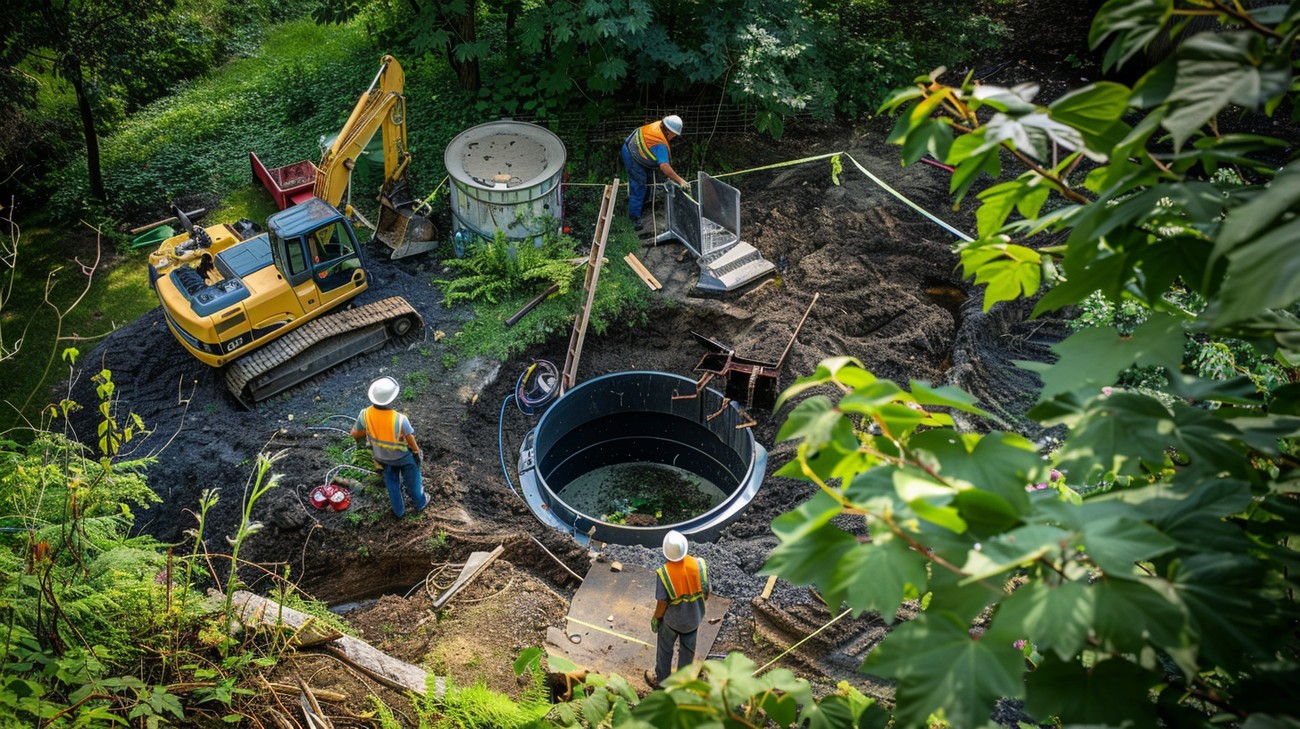Septic tank installation might not be a frequent topic of conversation, but it's crucial for homes not connected to a municipal sewage system. Whether you're constructing a new home or revamping an existing septic system, understanding the process and considerations involved in septic tank installation is essential. Let's delve into everything you need to know about this vital home installation.
Understanding Septic Systems
Before diving into the nitty-gritty of installation, it's helpful to grasp the basics of how septic systems work. Essentially, a septic system treats wastewater from your home through a combination of natural processes and human engineering. It consists of a septic tank and a drainage field, or leach field, which purifies the wastewater before it re-enters the groundwater system.
Preparing for Installation
Site Evaluation
An essential early step in septic tank installation is the site evaluation. This process involves assessing the property's soil composition, topography, and availability of space. Professional evaluators will determine the type and size of the system required.
Permits and Regulations
Obtaining the necessary permits is crucial before any installation work begins. Local environmental regulations will dictate the septic system's size, design, and allowable location. It's imperative to adhere to these rules to avoid fines and legal issues.
Selecting the Right Septic Tank
Septic tanks come in various materials, sizes, and configurations. The most common materials include:
- Concrete: Durable and long-lasting but heavy and more challenging to install.
- Plastic: Lightweight and easy to install but may be less durable over time.
- Fiberglass: Resistant to corrosion and cracking but can be costly.
The choice of material will depend on factors such as budget, soil conditions, and personal preference.
The Installation Process
Excavation
The first physical step in septic tank installation is excavation. This involves digging the hole where the tank will sit and creating trenches for the leach field. It’s vital to ensure that these are dug to the precise measurements outlined during planning to facilitate proper flow and function.
Tank Installation
Once the site is properly excavated, it's time to install the tank. This step requires careful handling, particularly for heavier concrete tanks. The tank needs to be placed on a stable foundation to prevent shifting, which could cause system failure.
Connecting the System
Next, the plumbing connections between your home and the septic tank are established. This stage involves connecting pipes from the house to the tank inlet, ensuring that wastewater flows efficiently into the system. Additionally, pipes leading from the tank to the leach field are installed to carry processed water away.
Creating the Leach Field
The leach field is a network of perforated pipes or chambers buried underground that disperses treated wastewater back into the soil. Creating this field involves careful planning to ensure it's optimally sized and properly connected to the tank.
Post-Installation Steps
System Testing
After installation, the system must be tested to ensure everything is operating correctly. Testing includes checking for leaks, verifying proper water flow, and ensuring the entire system aligns with regulatory standards.
Covering and Landscaping
Once the system has passed inspection, it's time to cover the tank and pipes, then restore the landscape. This involves backfilling the excavated areas and possibly reseeding grass or replacing other vegetation.
Maintenance Planning
Creating a maintenance plan is critical to ensuring your septic system's longevity. Regular pumping, typically every 3-5 years, depending on usage, is necessary to prevent buildup and failures. Also, keep an eye out for signs of septic issues, such as slow drains or wastewater backup.
Tips for a Successful Installation
- Hire Experienced Professionals: Work with licensed contractors experienced in septic system installation to ensure safety and compliance with local regulations.
- Consider Future Needs: Plan the system size not just for current needs but also future expansions or increased usage.
- Monitor Water Usage: Encourage water conservation to prevent overloading the septic system.

FAQ about Septic Tank Installation
How do I know if septic tank installation is necessary for my property?
If your property isn't connected to a municipal sewer system, you'll likely need a septic tank installation. Homes located in rural areas or lots outside of city limits typically rely on septic systems for wastewater management. Check with local authorities or a septic professional to confirm your requirements. Paying attention to municipal guidelines and environmental regulations is crucial to determining the necessity of septic installation, as it ensures both compliance and sustainability.
What factors should I consider when planning a septic tank installation?
When planning for a septic tank installation, several factors come into play. Begin by assessing the size of your household, as this dictates the tank's capacity. The soil type and condition on your property also affect installation due to varying percolation rates. Additionally, consider future expansion plans, proximity to water bodies, and local building codes. Each of these factors influences system design, ensuring your septic installation meets all necessary health and safety guidelines.
How long does septic tank installation typically take?
The duration for a septic tank installation can vary significantly depending on several factors, including soil conditions, weather, and the complexity of the project. Generally, the installation process may take anywhere from one to three weeks from start to finish. Initial site assessments and permits can take additional time, so planning should begin well in advance. Efficient project management and hiring experienced professionals can help ensure the septic system installation is completed as quickly as possible, without compromising quality or safety.
What permits are required for installing a septic system?
Before commencing with septic tank installation, it's important to obtain the necessary permits from your local authorities. Typically, you'll need a septic system permit, a site evaluation, and possibly a construction permit depending on your area's regulations. The process often includes submitting plans, undergoing soil and percolation tests, and ensuring the design meets all local environmental and health codes. Consulting a professional installer can streamline this process as they are familiar with regional requirements and can assist in securing the appropriate documentation.
Can I perform my own septic tank installation?
While it's theoretically possible to conduct your own septic tank installation, it's generally not recommended unless you have expertise in the field. Installing a septic system involves complex tasks like site testing, precise excavation, and managing plumbing connections, all of which require specialized knowledge and tools. Improper installation can lead to costly repairs, health risks, or legal issues. Hiring licensed and experienced professionals ensures compliance with regulations and standards, providing peace of mind regarding the system's longevity and effectiveness.
How is the size of a septic tank determined?
The size of a septic tank for installation is determined primarily by the number of bedrooms in a home, which estimates water usage and waste output. For example, a typical three-bedroom house might require a 1,000-gallon septic tank. However, these numbers can vary based on local regulations, the number of users, and specific household needs. An experienced septic installation contractor will assess these variables and soil conditions to recommend the most suitable tank size, ensuring efficient operation while reducing the risk of overflows or premature system failure.
What's the difference between septic tank installation and septic system installation?
Septic tank installation refers specifically to the placement and setup of the tank itself, which serves as a container for collecting and breaking down sewage. In contrast, septic system installation encompasses the entire process, including the tank, drain field, and all necessary plumbing connections and components. A comprehensive septic system installation is crucial for the effective and safe treatment of wastewater. All parts must work harmoniously to prevent environmental contamination and maintain system efficiency.
Are there seasonal considerations for septic tank installation?
Yes, seasonal weather patterns can impact septic tank installation timelines and procedures. Ideally, installation occurs during dry seasons when the ground is more stable and easier to excavate. Wet or frozen conditions present challenges such as soil displacement and difficult digging, which could hamper installation efforts and potentially damage the system. Planning your septic installation during optimal weather conditions facilitates smoother work, ensures soil integrity, and helps prevent future drainage issues caused by improper setup.
How should I prepare my property for a septic tank installation?
Preparing your property for septic tank installation involves several steps aimed at streamlining the process and ensuring it complies with environmental standards. Start by clearing the installation area of obstacles like trees and debris. You may also need to have a site evaluation and soil testing performed to determine the best location for your system. Ensure that necessary access is available for construction equipment and that permits and inspections are organized beforehand. Adequate preparation helps mitigate unforeseen issues and promotes efficient, problem-free installation work.

Cost Breakdown
Typical Price Ranges
Septic tank installation costs can vary widely based on location, tank size, and type. On average, homeowners can expect to pay between $3,000 and $7,000 for a complete installation. However, prices can climb upwards of $10,000 or more for larger, more complex systems.
For a basic, conventional septic system using a concrete tank, the costs typically fall between $3,500 and $6,000. On the other hand, more advanced systems, like those using aerobic treatment or constructed wetlands, might set you back anywhere from $10,000 to $20,000.
Factors That Affect Cost
Several factors can influence the cost of installing a septic tank:
- Soil Quality and Composition: The type of soil on your property can significantly affect costs. Well-draining soils reduce costs, whereas rocky or clay-like soils will require additional work, increasing costs.
- System Type: Different systems have different price tags. Traditional anaerobic systems are generally cheaper, while aerobic systems or those with advanced treatment add to the expense.
- Tank Material: Septic tanks come in various materials like concrete, fiberglass, and plastic. Concrete tanks are usually less expensive ($700-$2,000), while fiberglass and polyethylene tanks can cost a bit more ($1,500-$2,500).
- Permit Costs: Don't forget to factor in permits. Depending on your location, permit costs can range from $250 to $1,000.
- Labor and Excavation: Labor can vary dramatically, with rates usually ranging from $1,500 to $4,000, depending on the complexity of your installation and local rates.
Cost Comparison: Budget vs Premium Options
Choosing between a budget or premium septic tank setup is primarily a decision about materials and system types.
Budget Options: A basic anaerobic system with a concrete tank is your best bet if you're budget-conscious. These systems work well for smaller properties with suitable soil conditions, costing between $3,000 and $5,000.
Premium Options: If your property requires advanced treatment to discharge effluent, or you're interested in more durable materials like fiberglass, you might look at premium systems. These systems not only range between $10,000 to $20,000 but also typically come with lower maintenance costs due to their efficiency and durability.
Hidden Costs to Consider
Some costs might not be apparent at first but can significantly impact your budget:
- Land Clearing and Landscaping: If you need to clear trees or regrade your land, expect additional expenses that can range from $500 to $3,000.
- System Maintenance: Regular septic system maintenance, including pumping (every 3 to 5 years), can cost $200 to $500 per session.
- Repairs and Replacements: Unforeseen repairs after installation, such as fixing leach field issues, could set you back $1,000 or more.
- Additional Components: Installing additional components like risers, filters, or alarms might also bring unforeseen costs.
Ways to Save Money
While septic tank installation isn't cheap, there are several approaches to cut down on costs:
- Get Multiple Estimates: Shop around to get quotes from several contractors. Different companies may offer varied pricing for the same work.
- Plan Off-Peak: If possible, schedule the work during the off-season when contractors might offer lower rates.
- Choose Wisely: Opt for a tank and system type that suits your needs rather than the most expensive option. Discuss your specific requirements and potential savings with your contractor.
- Maintenance Prevention: Regular maintenance and inspections help avoid costly repairs. Remember, an ounce of prevention is worth a pound of cure.
- DIY Landscaping: Consider handling post-installation landscaping work yourself to save on labor costs.

Timeline & Process
1. Initial Planning and Permitting (1-2 weeks)
This is where the groundwork begins. Before any physical work can happen, planning is crucial. During this phase, you'll conduct soil tests and consult with professionals to design a suitable system for your location and household needs.
To prepare: Gather property plans, ensure easy access for soil testing, and research local regulations. This phase can drag on if you're missing essential documents or haven't thoroughly researched local legal requirements.
Dependencies: The timeline may extend if soil conditions are atypical or if there are delays in obtaining necessary permits from local authorities.
2. Excavation and Site Preparation (3-5 days)
Once you have all the necessary approvals, it's time to break ground. Your contractor will excavate the soil where the septic tank will be placed, ensuring the site aligns with the design specifications.
To prepare: Clear the area of any debris or obstructions, such as rocks or stumps, and ensure machinery can easily access the site.
Dependencies: Weather conditions can delay this phase, so aim for a week with a favorable forecast. Additionally, make sure that all machinery and labor are scheduled and ready to go once permits are in hand.
3. Tank Installation (1-2 days)
With the site prepped, the actual installation of the septic tank can occur. The tank will be carefully lowered into its designated spot, and necessary plumbing connections will be made.
To prepare: Confirm that all tank components are on site and in good condition. Have a contingency plan for unexpected issues like equipment malfunctions.
Dependencies: Ensure the tank being installed meets specifications outlined in the permit approval. Any deviation can result in setbacks.
4. Drain Field Installation (2-4 days)
This is where the wastewater drains from the septic tank. During this phase, trenches are dug and piping is laid out according to your design plan. The field is then covered with a layer of gravel or sand and earth.
To prepare: Have the correct quantities of materials delivered ahead of time, and confirm your contractor is experienced in drain field installation.
Dependencies: Like excavation, weather is a factor. Rain can delay progress, as it leads to muddy working conditions that might compromise the installation.
5. System Testing and Inspection (1-2 days)
After installation, the entire system must be tested to ensure it works properly. Local authorities will typically need to inspect the septic system to verify it complies with all regulations.
To prepare: Be available for inspections and accessible as the point of contact for both inspectors and installation crews.
Dependencies: Scheduling an inspector may depend on local office availability, so book this appointment in advance to avoid delays.
6. Backfilling and Site Restoration (2-3 days)
When the inspection is complete and approval is granted, the area around the septic tank and drain field is backfilled. The site is then restored to a natural state as much as possible, often involving reseeding grass or replanting vegetation. To prepare: Decide on landscaping plans if they’re necessary for your property and arrange any additional materials or labor needed for this task in advance. Dependencies: Unforeseen issues found during inspection might prolong this phase, requiring more work before finalizing the site.
Final Thoughts
Septic tank installation is a crucial step for maintaining a healthy home environment, ensuring your waste management system functions efficiently. We’ve covered how essential proper sizing, location, and compliance with local regulations are, especially when serving homeowners in Sacramento, CA, where specific guidelines can vary.
If you’re considering a septic tank installation or just want to learn more about your options, we’re here to help. Our team at HouseIdea is your trusted local expert, ready to answer your questions and guide you through the installation process. Reach out to us today to discuss your needs or to schedule a consultation. We look forward to helping you make informed decisions for your home!
Tags: plumbing, wastewater treatment, home improvement,



















